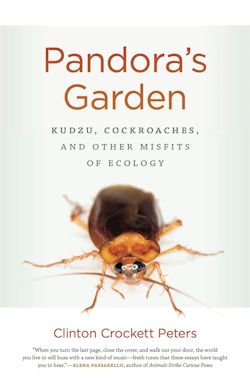SEJournal Online is the digital news magazine of the Society of Environmental Journalists. Learn more about SEJournal Online, including submission, subscription and advertising information.
BookShelf
“Pandora's Garden: Kudzu, Cockroaches, and Other Misfits of Ecology”
By Clinton Crockett Peters
University of Georgia Press, $24.70
Reviewed by Christine Heinrichs
In this collection of essays, author Clinton Crockett Peters mines life experiences to provide unique insight into how humans perceive and treat many invasive and unwanted species, from disgusting cockroaches to gnarly Asian carp.
Peters brings his Ph.D. in creative nonfiction to complex issues. He tells stories with a love of the outdoors and a background in natural history, moving in a literary direction.
He starts strong, with a childhood memory of tasting the scoop of what seemed to him God’s ice cream dropped on his head while his family was vacationing at North Padre Island in his home state of Texas. God had instead sent a gull to drop a load of poop on the nascent philosopher. According to Peters, it was warm, gritty and pasty, with a fiery afterburn.
Each story resounds with echoes,
some faint and some piercing,
of the pitfalls of ecological tampering.
Peters’ strength is in finding a nugget and telling a story. His subjects range from rabbits in Australia, now an invasive scourge, to Texas’ snow monkeys and prairie dogs.
Prairie dogs in particular are held in high esteem by Peters, who had fond memories of a childhood pet. He’s found a kindred spirit in Lynda Watson, prairie dog rescuer who is helping these rodents recolonize Texas prairies. Telling her story allows him the latitude to champion the environmental niche prairie dogs occupy: a keystone species for their ecosystem, in which 89 species rely on them for their burrows.
Storytelling allows Peters to summarize history in a few sentences, setting up the rest of the story. Human events being what they are — complex and nuanced — make this feel like poetic license. I couldn’t help wondering what got left out in the cause of telling a good yarn.
His extensive bibliography, cited for each essay, assures me that he isn’t willing to sacrifice accuracy for drama, though.
 |
Truth is indeed stranger than fiction, with his list of weird animals, insects, fish, reptiles and plants — Florida panthers to cockroaches, rattlesnakes to stinking cedar. He brings the literary canon into the essays, freely connecting to sources ranging from news reports and magazine articles to the Bible. Even a literal fallen sparrow, for a meditation on life, death and kids.
One truly grisly event is the annual Sweetwater rattlesnake roundup, with which I was unfamiliar — dare I say, only in Texas? Or would that inspire SEJ member Craig Pittman, author of “Oh, Florida!: How America’s Weirdest State Influences the Rest of the Country,” to one-up me with something from Florida?
The depredations of kudzu are familiar, but Peters finds a new way to tell the story in the biography of Channing Cope, kudzu’s champion in Georgia and “the Howard Stern of the Depression.”
Each story resounds with echoes, some faint and some piercing, of the pitfalls of ecological tampering. Many exotics become valued products: corn, potatoes, tea, sugar, even cattle and chickens. Others run amok.
As someone who often feels that my journalistic writing drains the life out of issues, Peters reminds me of how vibrant writing can be.
I met him at the Mayborn Literary Nonfiction Conference, where we were both working on book proposals. My work is enriched by Peters’ willingness to reach for the extreme to describe and find meaning in the natural world, of which we are but a single species.
As he concludes, Peters fills the reader in on his family background. He recounts his banker father’s business missteps, which damaged him professionally, plunging the once-prosperous family into poverty. He examines his family’s experience against the metaphor of history of life on Earth, for ways his life, and the future of life on Earth, can be different.
“I don’t know how to proceed except to tell my story, my family’s and the world’s as entwined as helixes of DNA. The full picture, the jumbled song, the cosmic creation myth of our lives in rock as told through ascendants and departures. My child will have to read the fossilized footprints and decide where they lead.”
Christine Heinrichs writes about wildlife and domestic poultry from her home on the California coast. Her “Backyard Field Guide to Chickens” is a dream book for feathery beauties. Follow the elephant seals through the year in her monthly column for The Cambrian.
* From the weekly news magazine SEJournal Online, Vol. 3, No. 26. Content from each new issue of SEJournal Online is available to the public via the SEJournal Online main page. Subscribe to the e-newsletter here. And see past issues of the SEJournal archived here.














 Advertisement
Advertisement 



